In My Workspace
I looked back on the different workshops I have worked in since I came back to live and work in the UK. Two things that all have in common are my workbench and my work tools. They’ve never changed in nigh on 60 years. What I started with I still have and still use. What I bought in the mid-sixties I still use. A marking gauge, a mortise gauge, spokeshaves, bench planes, tenon saws, such like these are still the tools I reach for every day. In January 1965, I began my apprenticeship. Snow-covered the streets and the workshop roof where I would work and train and serve for the foreseeable future. 57 years later I have no regrets at my choosing woodworking as a way of life for me. Between that January morning and today, I have seen many changes and I have tried them to see how they might fit into my life. Most of the machine methods seemed to end up driving me to work faster and even beyond my control. Something about the swirling cutterheads drove me to get the job done as soon as possible so I could shut them down and stop their noise, their mess, their pushing that drove me so. Those ten-hour days on a router, a tablesaw, a thickness planer and such. The day I stopped all of this and changed the course of my life was a magical day that reminded me of other such days when I stopped doing what I shouldn’t be doing for a living to take charge of my life, instead of being driven by others or indeed purely economic considerations. Stopping the mechanisms we consider to be essentials because of economics and such is often beyond our control, but I worked toward that end bit by bit. Eventually, I was able to climb down from the conveyor belt and live a life of my own choosing. How glad I am that I could see a way out of commercialism and begin to start out pioneering a new direction.
Leaving the USA and my beloved Texas, with the rebirth that often comes from living in a new culture to achieve a new life as a full-time lifestyle woodworker, took many years of consideration for preparedness. Mostly it was dismantling my own precepts and preconceived ideas of life and work. But it was also the precepts and expectations of others that I had to dismantle too. It is all too easy, thinking you own what you are and what you are doing, only to find others can somehow expect to have ownership of you by all types of ligatures. I liken this to owning possessions. Everything from owning a house, a car, a mass of personal possessions, like tools and equipment, and then finding that you don’t actually own them–they own you! Many have lamented me taking down my mass of woodworking tools from the workshop walls and cupboards surrounding me that I have owned through the years of my woodworking. Well, I still have them, but what you see now in my workshop is actually the real me in control of my woodworking environment, so please celebrate with me as what you see is what you get and all pretention and any pretentiousness is gone.
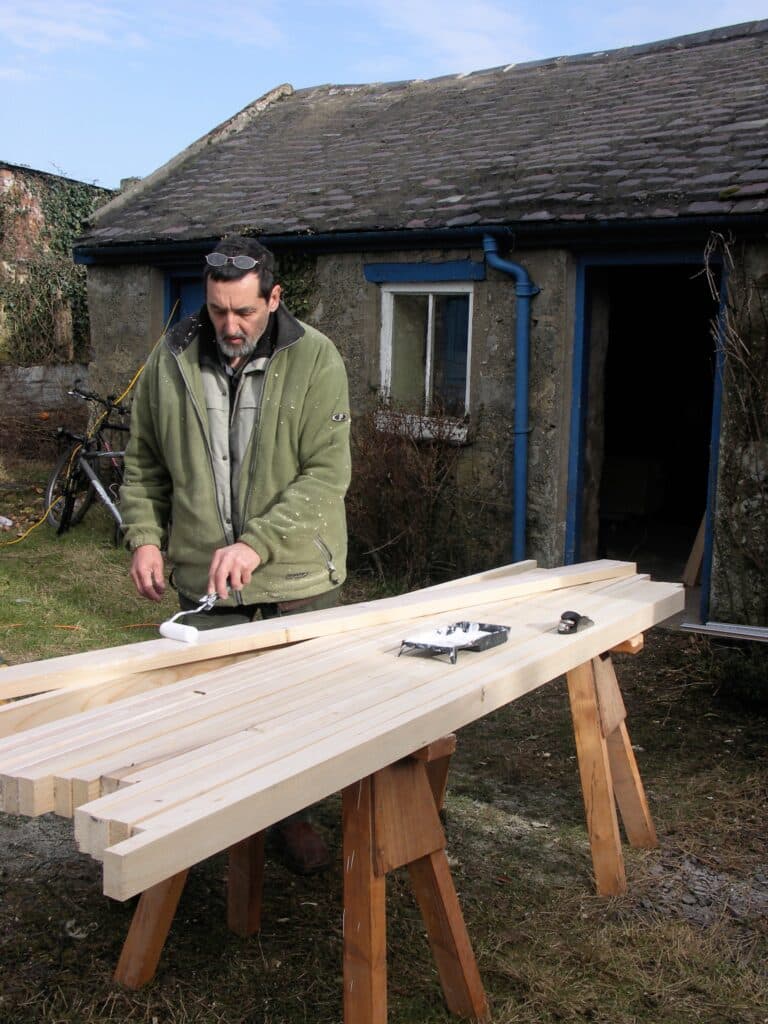
When I first began establishing myself back in my native Britain it was on the Isle of Anglesey (Ynys Môn in Welsh). Not that easy a place to survive let alone thrive with its isolation and dependency on a more local economy, but from the coasts of this small island my plans were formed, and survive I did. Here, I started my new future from scratch. Had I relied on the local economy to live based on making and teaching I would have most likely died. But it was in such isolation that I spent my evenings and weekends drawing, designing and planning the steps it would take to restart and reconfigure my new life. The island is largely a retirement community with some small industry and a now decommissioned nuclear power station; more a mix of peoples if you will of those who wanted a seaside within a few miles and a chilled way to live. Anglesey can be very cold. The quietness was conducive to my writing and nature study, but after a hectic life of 16-hour days, six and seven days a week over two decades, the pastoral element helped me to solidify my will to establish a new life reaching out to a world beyond my new borders. I found an old farmhouse property to rent with a few rugged stone outbuildings. It was a beginning, just a beginning, but one that wouldn’t last too long. Often we are disadvantaged by people we come to know and associate with, but even that can launch us into a more successful future. I have needed to rebuild my life and my future several times brick by brick. When you do this, you really value what you’ve got.
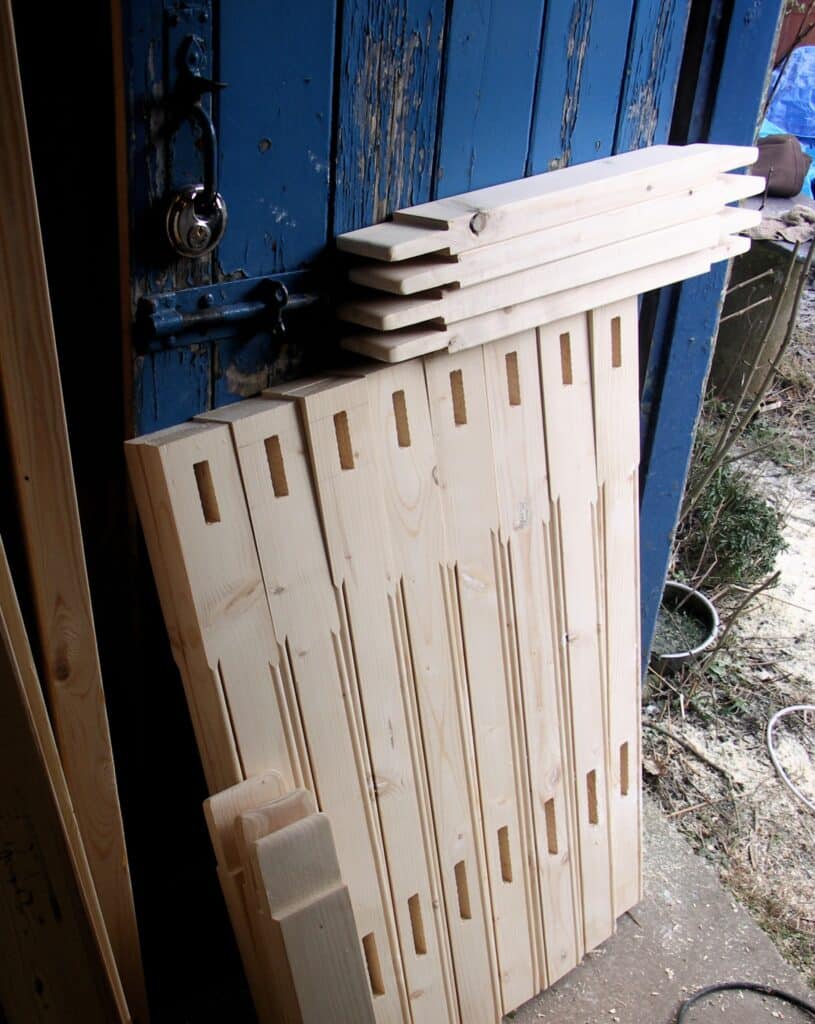
The picture at the top was my first workshop back in the UK. The picture above resulted from my making ten workbenches for the new school I would begin in 2011.
I actually liked this workshop despite its damp problems. In North Wales you want something solid between you and the great Atlantic beyond the more local Irish sea and Northern Ireland and Eire. Stone may be cold but it is pretty much immovable and fireproof too. A good woodstove works really well.

The views of the Snowdonia mountain range help resettlement when the weather is right.
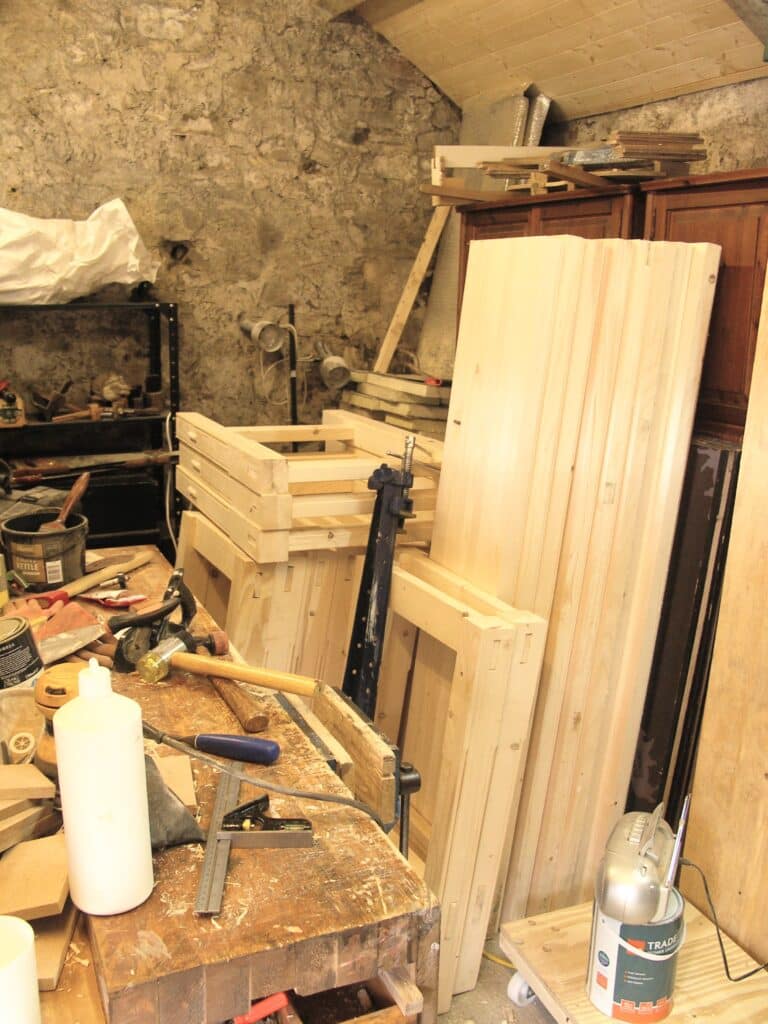
And things can get pretty tight in small workshops when you are making ten workbenches.
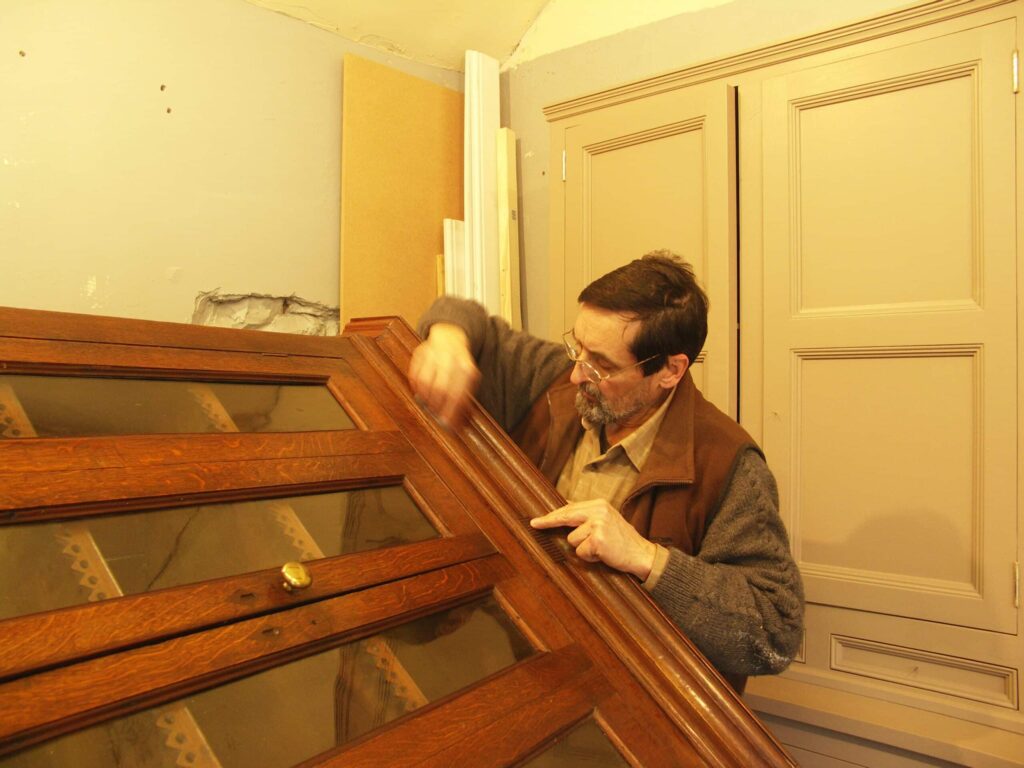
I had a small garage workshop in my next rental home, but I also had a workshop in Penrhyn Castle where I held my classes. My home garage was literally a single-car garage and I had three machines from which I milled all the 500 pieces I needed for classes in the Castle. To say it was compact is an understatement but it was how I survived. The castle made up for everything. I had a beautiful workshop there for five years until the contract ended and we relocated to central England. Wales was a wonderful transition for me and my family.

From Wales to a more central UK meant many new beginnings and I am grateful to the Sylva Foundation for enabling me once again to find a stepping stone and a place to work from. By now we had moved house four times in almost as many years.
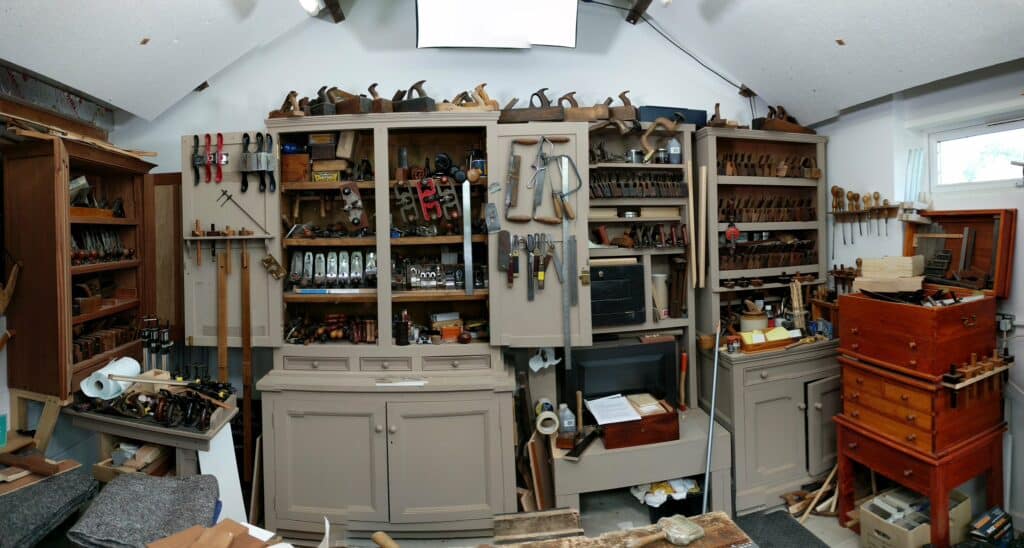
Here in Oxfordshire and in a terribly compact space, I started to thin down ready for our next and final move. On the home front, I had a nice garage workshop and it was at this point that we tried to match my circumstances to what the majority of people out there had access to. The garage workshop needed to be representative of what people were using at home too. The garage I was in was typical of the UK and lo and behold, after a survey of those following us online, we found that a massive percentage had the same space. This then set the parameters for our studio garage workshop here at our own building in Abingdon. Over the past four years, since our arrival in Oxfordshire and Abingdon, we have established what I consider to be the most likely workshop I will ever need to work from here in the UK. The machines I once needed for my hands-on classes are now gone. I rely only on a 16″ bandsaw for resawing my wood. The rest is all handwork and I love it. I will never mass-make anything again.
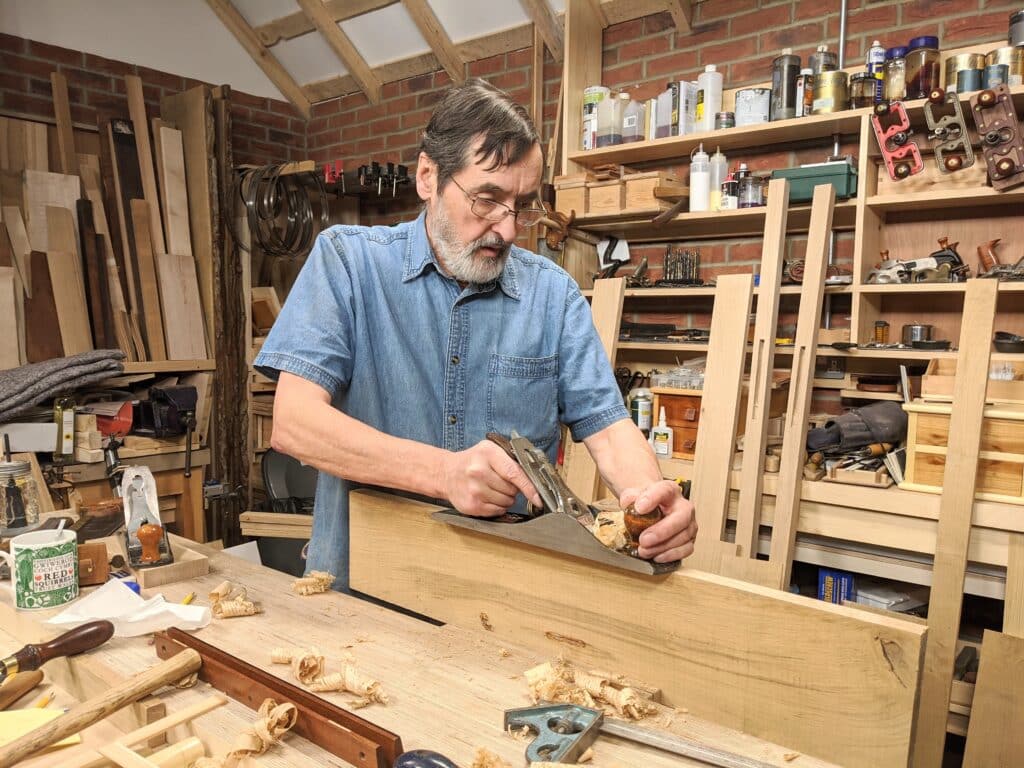


I moved from a very big house to a smaller one a year ago. This new house is older, but it has a garage that the bigger one didn’t have. If I put my car into the garage the shop space reduces drastically, so I decided to rent a garage place near the house and use all my garage as a shop. I have my workbench, my sharpening station, my shelf with tools and my wood on it. The only machine is a cheap pillar drill. It’ s true that it can be rather “tight” most of the time, but it works peefectly for hand tool woodworking. My wife calls it “my exile country”. No dust, no noise, only shavings on floor and the sound of mallets, planes and saws. Since I work as a operation technician in a petroleum refinery, quietness of my shop is almost a therapy. I try to learn from Paul all as I can and I progress on my skills step by step, little by little. I don’t need anything more, for the moment at least.
I too retired out of the refinery services field and the first thing I did was build a small 120 Sf shop. To me it is so peaceful to be by myself and hand work the wood. I’m predominantly using my great grandfathers hand tools plus an assortment of other planes, chisels and saws that I have brought back from the brink.
The sound a well sharpened plane iron making shavings can not be adequately described.
Ligatures. I knew the feeling too well as an employee. I then spent twenty years of my life as my own boss. It was rewarding to select and buy equipment freely to satisfy the needs of the job, rather than being obstructed by accountants and their fears of spending.
Paul , thanks for a very engaging Blog . The theme of “reducing to the necessary ” strikes home with me . When you were working in a damp shop , such as the one you had in Wales , how did you handle issues with rust forming on your tools ? Regards , Peter
I too have a single car garage made in 1954(carved in the concrete floor) and I have everything on a mobile base. For larger jobs I have a Dewalt 13in thickness planer, a mid 60s Delta Unisaw and recently purchased a Rikon 14in bandsaw. The Delta 6in jointer lives in the basement of the house along with the Excalibur 16in flatbed sander. However I have expended my hand plane collection and am setting them all up to be used. I am retired now and have the time to spend in the shop as well as some piecework that I get from a company I have been dealing with for about 20yrs that largely pays for my tools. Apparently none of the shops they contacted want to make small bits like pipe fitters wedges and pipe plugs. Small bits but often lots of them. That job alone would keep my shop going. Something to think about. There is always someone looking for something they cannot get. Along with that this is my “happy place” and my wife loves that I spend my money on tools rather than a pub night with the boys. Satisfaction guaranteed. Merry Christmas all and may the universe be kind to all of us. This is a wonderful thing we do.
You are inspiring. I remember that free sample dvd I got that changed my life. You were the first that when I followed it worked. No fuss no frills real work. I love following in your journey and feel like I have grown with you. Your impact on the community of woodworker/craftsman is huge. Because of all of this I now make a living with wood. Even making kitchens cutting dovetails and using real wood which goes nicely with furniture! So a big thank you for following ans sharing your journey with us!
I started 45 years ago buying power tools. They killed the fun I discovered and I am going back to to basic hand tools that I learned in 1955 8th grade.
The only power tool left will be my wood lathe.
I am Keeping the power tools for work like building a table for the tool shed in my yard, no skil, no fun job. just get er done
I have a basement workshop with a working space about the size of your garage. After watching your videos for about 5 years or so, I looked around and realized the only thing I need more of was time. My Mom can’t believe I can, come up with things as big as they are in such a small space, as she puts it. Also I don’t think I’ve touched my power router in 3 years. The hand plane router is more versatile and fun!
I tried to sand a round piece. Made a bow sander. It’s a curved piece of wood, about 18” long, with a strip of paper stapled to it for now. Works good in shaping wormy chestnut
Dear Paul how I cherish the day I found you……your words of totall encouragement bring a tear to my eye…..my dear wife of 53 years has early dementia. I read your words and they simply help me keep going.
Thank you john 2v
THAnks Paul. Sure, I dream of a 1500 square foot timber framed workshop outbuilding with a nice wood stove. Having said that, I am quite content working along the wall in my garage. Maybe someday we move, maybe we don’t. What I have let’s me build whatever I want. I try to be conetnet with that and not wish for more.
I think it is important to live and work within the limits of our habitation. This is often determined by our perception of what we need. I have been in so many workshops of the size you mention, some bigger too, in amateur realms and found that production levels were actually lower than I might have expected. The machines occupied the bulk of the space and most of them were used once or twice in a month and longer. This was only in the USA, I might add, where house lots can be an acre and more on up and the garage footprint and might be almost as big as the house. This is very different to the UK and Europe. I doubt that I would ever go back to a large workshop again. I always ended up in a corner of those that were big. I was content with my back 5 feet from the wall and my bench up against the other. 200 sq feet suits me but a carport on the front is wonderful for the occasional overspill. I definitely think a shed for wood storage too. Maybe 600 feet total is good. If you can put all that under one roof surrounded with walls that’s great.
I have about 30m2, which would be just above 200sq ft, I think! It’s shared with bikes, landmowers etc, and I do park the car in there at times, so my bench has to have drawers and be on castors, but it’s a perfect size. I could get away with smaller too, as it has a small loft that I can store wood in (the neighbour has a single garage that is probably 18m2
The biggest problems I have are the cold, and light. It’s freezing, and not particularly easy to heat. It’s well protected from the wind, but also very well protected from the sun too, getting little natural light. Those two factors are far more important than I realised, as removing yourself from the sun in the summer (I’m talking Scotland, so perhaps summer should be in inverted commas!) is just as off putting as heading out in the cold in winter.
Unfortunately, properties in the mass UK market aren’t really designed for the plots that they sit on. They don’t take advantage of light or position their windows to the sun, that’s a function of luck in the off-plan world. I still consider myself lucky to have any space at all. Maybe I’ll knock down a wall and put in some French doors? How hard can it be!
Perhaps I am being too personal, but upon reading your like stories I often wonder why you did certain things, like move to Texas, then to Wales. Just wondering what motivated these huge changes. We so often here about why you work differently and understand but not for other things.
I think that through the blogs and other media the complete story is in there somewhere. Most people do move from time to time with career choices, family considerations, business needs and economic changes etc, my story is no different. My parents lived the closing years of their lives a 500-metre bridge walk from Anglesey (By the bridge in the post). When they passed there was nothing in Wales to hold me so I returned to England because it was where I was born. If anywhere in the USA was close to my desire for closing the years of my life it would likely be the Texas Hill Country. Texas as a whole was the best place for me to enjoy the mid-years of my life. Clean, clear rivers to swim in and fish, sunshine every day, enough wild places to feel safer. I could go on.
As a native Texan, I very much enjoy your appreciation for my home country – Texas. I work in a small garage and love shavings and such everywhere. Thank you for sharing, Paul. You impact more folks than you can imagine. I share many people f your blog posts with my kids, none of which are woodworkers.
Paul, I am a native of East Tennessee, but I did get the opportunity to spend 3 months in North Wales as a young man. I was a resident going between the towns of Boddelwidden, Wrexham, Chester, Rhos on Sea, LLandudno, Bangor etc. I have longed to get back to the beautiful settings I so enjoyed with the drive into Colwyn Bay and the hikes we took. I even had the opportunity to jump from Adam to Eve. Retired now, I am looking to build my first workshop. The woodworking projects I have done thus far are crude in comparison to yours, but they have helped out on our farm. Your use of hand tools has inspired me to dedicate more towards their use in the new shop, and I have garnered much knowledge in the way to proceed. Thanks much……..George
I moved to a new place five years ago, which enabled me to have a larger workspace – for which I am eternally grateful. That is due to having been 20 years in a eleven by thirteen foot space, where I made things and did painting and wrote – and went slowly nuts. I had no room for a real workbench, so used horses and planks. I think I spent more time cleaning up than working. So it can work the other way, as well. Now I have a workbench, a place to store more wood, a place for a lathe, etc. This is going to be my last home, at my age, and thus my last workshop. It’s going to be fun!
We bought the house we now live in – and where we’ll most probably grow old in – in 2019. I immediately started the conversion of the attached one bay garage into a shop.
My first shop.
It is 32m2, or 344 sq.ft. about 7.5 meters in length. At the moment it is almost controlled chaos in there. I still have a lot of work to do, but I am doing projects.
Being somewhat limited in space, I cannot justify a lot of big machines. After all, one needs to allow for both in- and outfeed for the band saw, the jointer/thicknesser, the table saw and the miter saw. I have all these machines (and more), but the only two I do use are the band saw and the donkey work remover (jointer/thicknesser). I plan to get a big pillar drill, and that should be it for machines.
I find that it is so much faster to just slap the bench hook down and cut a piece to length, rather than maneuvering the thing around my shop, trying not to knock stuff over whilst doing so. You see, I am very limited on ceiling height. Around 2 meters, and there is absolutely no way to change that without really major work (the roof is the concrete slab of the deck above).
Being limited on space, especially vertically, I am forced to approach my hobby in the “bring the tool to the work, not the work to the tool” approach.
And that is really, really liberating!
The big bonus for me is that I can enjoy listening to music, a podcast – or just the murmured sound of my hand tools. Or a small giggle when I get something just so. 🙂
Paul, you are the best at explaining how to Reinvent oneself. I wake up about 4am-5am to perform upkeep on my home so that I can have the afternoon to Reinvent myself. With my adult children struggling with their daily lives and my grandchildren doing the same I usually have the time to help them out. I’m in the process of creating my workshop but family life puts it on hold but the light is shining through the other side of the tunnel. Thank you for being there. Even with your email post I know that you and your team are keeping us on the other side of the digital divide thinking positively.
Hi Paul,
Just curious.
1) Was the bench you used in your videos of the keepsake box, the well sawn one with the bench stop your original bench from when you first started as apprentice and do you still have it?
2) What became of the pine bench you built in your back yard around 9 years ago?
You never seemed to use it, you used your old bench and then went to the plywood bench.
Love your work.
Paul,
I recently moved into my 4th shop space. I am 68 years old and started hand crafting furniture as a hobby 25 years ago. I have since built all of the furniture in our house and have sold some to others. My new space is 16 X 32 and dedicated to wood working. I have machines but use my hand tools as much as my skill level allows. I wish I had started out with hand tools only, but Norm Abrams was my first inspiration. I struggle with sharpening but you have been a huge help. I appreciate all that you do and enjoy your videos. I also feel a connection to you because I am a retired police officer, 37 years.
Paul,
I trained as a carpenter over 30 years ago, I qualified and began working on construction sites in London. I did this for about 12 months and then decided that was not the path for me. 20 years later with a young family, own house and 2 cats, I began a new journey back into the world of woodworking from the confines of my garage. My skills were very rusty (still are) but I still had all my hand tools given to me by the college all them years ago and decided I would start making. I watched countless videos, many of them from the US and pretty much all of them were of people using power tools, table saws and people making jigs for said tools. I bought myself many of these tools and my planes, chisels and handsaws were left to continue gathering dust in a wooden toolchest made by my fair hand circa 1989. I then happened upon a video of your good self creating furniture and joints with hand tools only and talking with such passion about it, it dawned on me I had been sold into an idea that joinery in the modern era was a power tool world with no place for chopping mortises by hand, cutting tenons and dovetails heaven forbid without a table saw. I watched your workbench video and decided to jump in and give it a go. The feel of working the wood with my own freshly sharpened and fettled tools took me back to my early college days, the smell of the wood being cut, the silky feel of the wood after planing, the feeling of joy when the joints all fit and the project comes together, the fact that the only unwanted noise in my workspace is my swearing when I make (lots of ) mistakes, the only dust created is when I reach for an old forgotten plane on top of a cupboard still in its box. I feel much happier and much safer using my own tools, I still own power tools and they definitely have their uses, but I must admit I find myself reaching for a handsaw now much more than I used to, I was taught how to sharpen my tools many moons ago but your wonderful videos have given me the appetite to actually do it again and reap the huge rewards. Thank you so much for leading me back to traditional joinery, i will continue this journey with great pride and if my kids show interest, they will be given this knowledge. You are a fantastic teacher and I wish you well in everything you do.